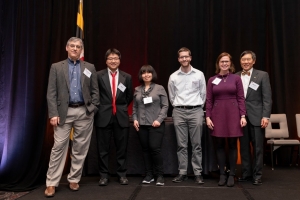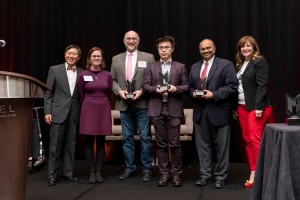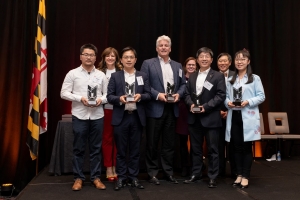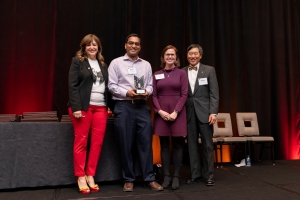Invention of the Year

The Invention of the Year award nominees are selected from prior year invention disclosures in three categories: physical sciences, life sciences, and information sciences. A panel of judges selected one invention from each category to win the 2018 Invention of the Year Award and one overall winner.
 “Cryogenic Ion Trapping and Storage System for Quantum Information”
“Cryogenic Ion Trapping and Storage System for Quantum Information”
Winner of the Overall Invention of the Year Award
Scientists around the globe are engaged in a race to create the world’s first scalable quantum computer, an invention that could revolutionize computing technology as we currently know it. Researchers at UMD have invented a new atom-trapping system to take the next step toward developing a scalable quantum computer. The system utilizes cryogenic technology, which operates at very low temperatures, to trap atoms that are used as building blocks to store and process quantum information for longer times. This apparatus may become an ideal test-bed to investigate both quantum algorithms and simulation of synthetic quantum matter with a number of qubits impossible to simulate on a classical computer.
The invention team includes researchers from the College of Computer, Mathematical, and Natural Sciences:
- Christopher Monroe, Distinguished University Professor & Bice Sechi-Zorn Professor, Department of Physics and Joint Quantum Institute (JQI)
- Guido Pagano, Post-Doctoral Researcher, Department of Physics and JQI
- Paul Hess, Post-Doctoral Researcher, JQI
- Harvey Kaplan, Ph.D. Student, Department of Physics and JQI
- Wen Lin Tan, Ph.D. Student, Department of Physics and JQI
- Philip Richerme, Former Post-Doctoral Fellow, Department of Physics

“AUGMENTED REALITY ENABLED CATHETER”
Invention of the Year: Information Sciences Category
Working with surgeons at the R Adams Cowley Shock Trauma Center, computing visualization experts at the University of Maryland have developed an augmented reality (AR) system that provides an accurate virtual representation of a catheter’s tip inside the human skull during external ventricular drainage (EVD), a lifesaving neurological procedure used to relieve the build-up of cerebrospinal fluid in the brain. Wearing an AR headset, a surgeon is able to virtually “see” both the location of the catheter’s tip and also see important patient data available from a computer tomography (CT) scan. This invention will allow a surgeon to complete this lifesaving medical procedure with more knowledge and accuracy.
The invention team includes:
- Amitabh Varshney, Professor and Dean, College of Computer, Mathematical, and Natural Sciences
- Sarah Murthi, M.D., Associate Professor of Surgery, University of Maryland School of Medicine; Trauma Surgeon, R Adams Cowley Shock Trauma Center
- Gary Schwartzbauer, M.D., Assistant Professor of Neurosurgery, University of Maryland School of Medicine; Neurosurgeon, R Adams Cowley Shock Trauma Center
- Xuetong Sun, Doctoral Student, Department of Computer Science
“Novel Method of Internal Organ Generation For Therapy and Research in Humans and Animals”
Invention of the Year: Life Sciences Category
Every 10 minutes a patient is added to the organ transplantation list, and on average 20 people die each day in the U.S. alone due to the lack of available life-saving organs. To address this critical gap in availability of organs for transplantation, resident genome editing experts at UMD have invented a technology that allows generation of “transplantation-ready” and immune compatible human cells and organs in pigs. The invention includes genome editing of pig embryos and complementing them with patient-specific stem cells to generate on-demand human organs for transplantation. This technology will likely revolutionize life-saving organ transplants and also provide a more relevant model to study human disease and treatment protocols.
The invention team includes researchers from the College of Agriculture and Natural Resources:
- Chi-Hun Park, Faculty Assistant, Department of Animal and Avian Sciences
- Bhanu Telugu, Associate Professor, Department of Animal and Avian Sciences
 “Strong and Tough Graphite-Paper Composites”
“Strong and Tough Graphite-Paper Composites”
Invention of the Year: Physical Sciences Category
Scientists are trying to prevent the further collection of plastic waste in landfills by inventing new biodegradable materials that are cheap to manufacture and can eventually replace plastic. University of Maryland researchers have developed a potential replacement for petroleum-based plastics and metal-based structural materials: a high-performance hybrid material of graphite and cellulose that is cheap to manufacture and fully degradable. The material is made by dispersing fine graphite flakes into nanofibrillated cellulose (NFC) dissolved in room temperature water. The resulting stable and homogeneous graphite-NFC slurry is then printed into large sheets that, once cast dried, are not only stronger than most steel, but also significantly lighter.
The invention team includes researchers from the A. James Clark School of Engineering:
-
Liangbing Hu, Assistant Professor, Department of Materials Science and Engineering and Maryland Energy Innovation Institute
- Yubing Zhou, Professor, Department of Materials Science and Engineering and Maryland Nanocenter
- Chaoji Chen, Professor, Department of Materials Science and Engineering and Maryland Nanocenter
- Teng Li, Associate Professor, Department of Mechanical Engineering and Maryland Energy Innovation Institute
- Robert Foster, Executive Vice President of Development, Trinity Rail Group
